2026届高考二轮英语复习:人与社会阅读 课件(共27张PPT)
文档属性
| 名称 | 2026届高考二轮英语复习:人与社会阅读 课件(共27张PPT) |  | |
| 格式 | pptx | ||
| 文件大小 | 1.8MB | ||
| 资源类型 | 教案 | ||
| 版本资源 | 通用版 | ||
| 科目 | 英语 | ||
| 更新时间 | 2025-07-16 21:00:58 | ||
图片预览


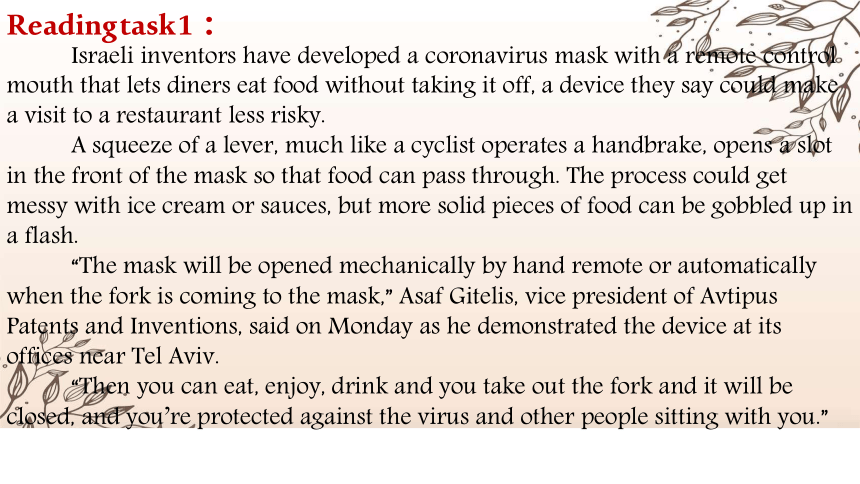
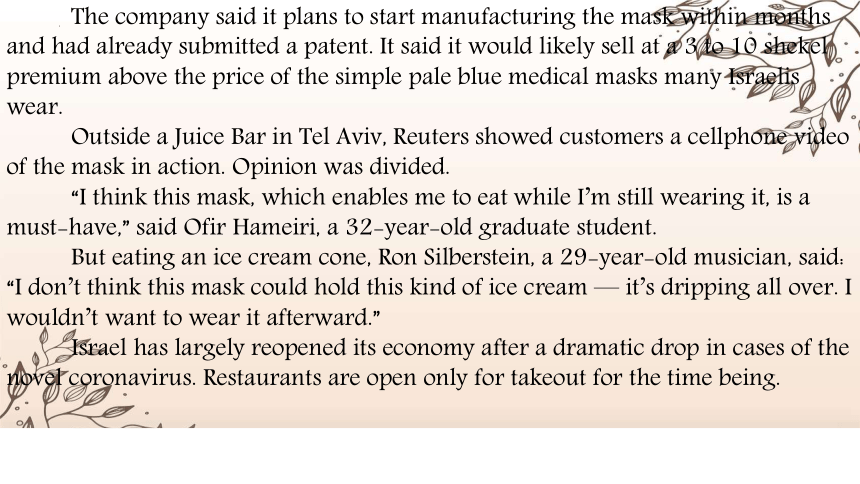
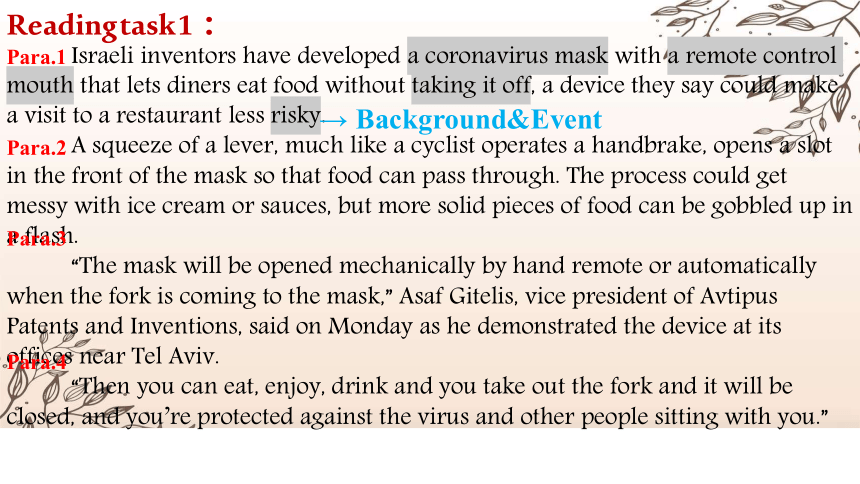
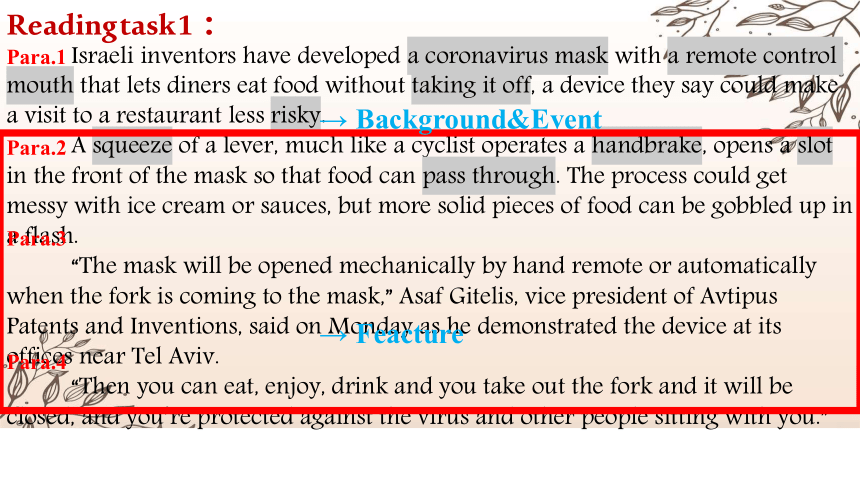
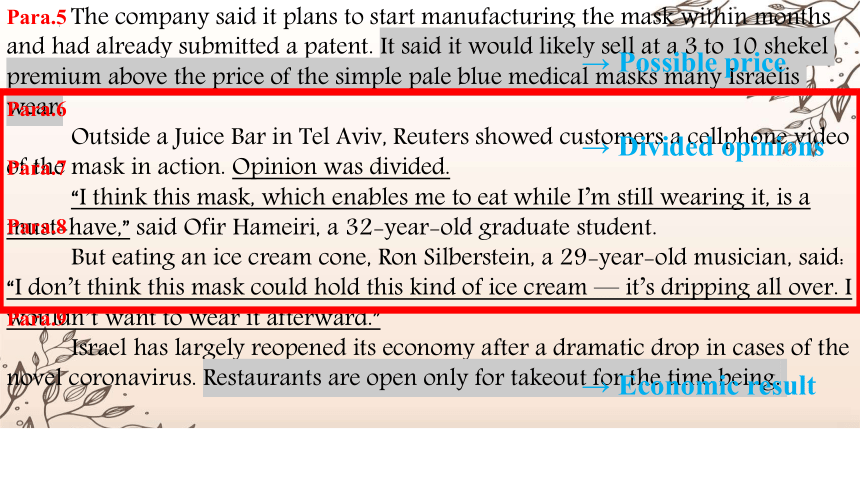
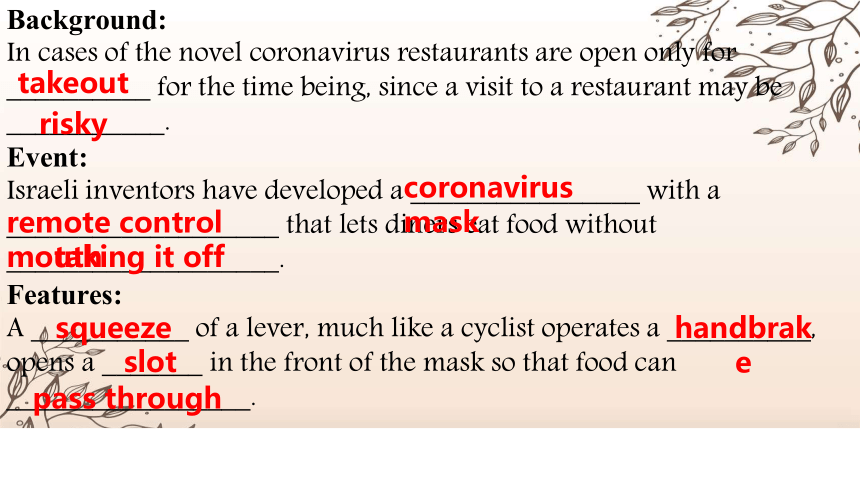
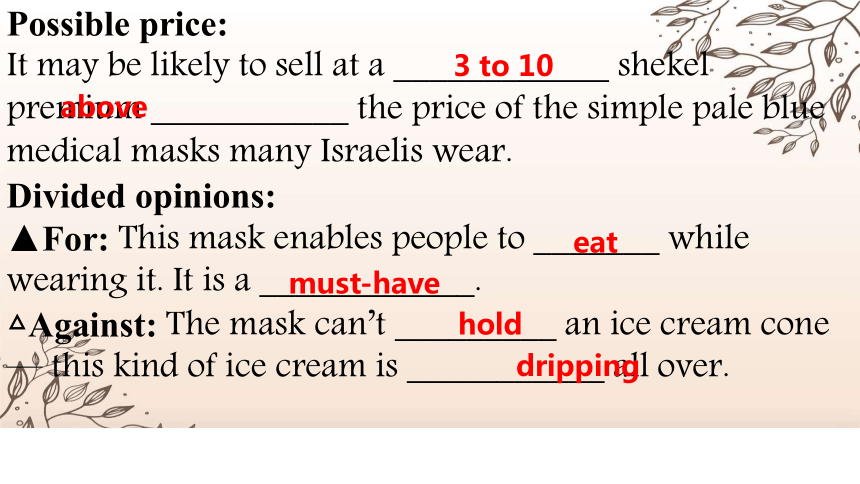
文档简介
(共27张PPT)
第四章 悦读群文提能力
第二节 人与社会
Reading task 1:
Israeli inventors have developed a coronavirus mask with a remote control mouth that lets diners eat food without taking it off, a device they say could make a visit to a restaurant less risky.
A squeeze of a lever, much like a cyclist operates a handbrake, opens a slot in the front of the mask so that food can pass through. The process could get messy with ice cream or sauces, but more solid pieces of food can be gobbled up in a flash.
“The mask will be opened mechanically by hand remote or automatically when the fork is coming to the mask,” Asaf Gitelis, vice president of Avtipus Patents and Inventions, said on Monday as he demonstrated the device at its offices near Tel Aviv.
“Then you can eat, enjoy, drink and you take out the fork and it will be closed, and you’re protected against the virus and other people sitting with you.”
The company said it plans to start manufacturing the mask within months and had already submitted a patent. It said it would likely sell at a 3 to 10 shekel premium above the price of the simple pale blue medical masks many Israelis wear.
Outside a Juice Bar in Tel Aviv, Reuters showed customers a cellphone video of the mask in action. Opinion was divided.
“I think this mask, which enables me to eat while I’m still wearing it, is a must-have,” said Ofir Hameiri, a 32-year-old graduate student.
But eating an ice cream cone, Ron Silberstein, a 29-year-old musician, said: “I don’t think this mask could hold this kind of ice cream — it’s dripping all over. I wouldn’t want to wear it afterward.”
Israel has largely reopened its economy after a dramatic drop in cases of the novel coronavirus. Restaurants are open only for takeout for the time being.
Reading task 1:
Israeli inventors have developed a coronavirus mask with a remote control mouth that lets diners eat food without taking it off, a device they say could make a visit to a restaurant less risky.
A squeeze of a lever, much like a cyclist operates a handbrake, opens a slot in the front of the mask so that food can pass through. The process could get messy with ice cream or sauces, but more solid pieces of food can be gobbled up in a flash.
“The mask will be opened mechanically by hand remote or automatically when the fork is coming to the mask,” Asaf Gitelis, vice president of Avtipus Patents and Inventions, said on Monday as he demonstrated the device at its offices near Tel Aviv.
“Then you can eat, enjoy, drink and you take out the fork and it will be closed, and you’re protected against the virus and other people sitting with you.”
Para.1
Para.2
Para.3
Para.4
→ Background&Event
Reading task 1:
Israeli inventors have developed a coronavirus mask with a remote control mouth that lets diners eat food without taking it off, a device they say could make a visit to a restaurant less risky.
A squeeze of a lever, much like a cyclist operates a handbrake, opens a slot in the front of the mask so that food can pass through. The process could get messy with ice cream or sauces, but more solid pieces of food can be gobbled up in a flash.
“The mask will be opened mechanically by hand remote or automatically when the fork is coming to the mask,” Asaf Gitelis, vice president of Avtipus Patents and Inventions, said on Monday as he demonstrated the device at its offices near Tel Aviv.
“Then you can eat, enjoy, drink and you take out the fork and it will be closed, and you’re protected against the virus and other people sitting with you.”
Para.1
Para.2
Para.3
Para.4
→ Feacture
→ Background&Event
The company said it plans to start manufacturing the mask within months and had already submitted a patent. It said it would likely sell at a 3 to 10 shekel premium above the price of the simple pale blue medical masks many Israelis wear.
Outside a Juice Bar in Tel Aviv, Reuters showed customers a cellphone video of the mask in action. Opinion was divided.
“I think this mask, which enables me to eat while I’m still wearing it, is a must-have,” said Ofir Hameiri, a 32-year-old graduate student.
But eating an ice cream cone, Ron Silberstein, a 29-year-old musician, said: “I don’t think this mask could hold this kind of ice cream — it’s dripping all over. I wouldn’t want to wear it afterward.”
Israel has largely reopened its economy after a dramatic drop in cases of the novel coronavirus. Restaurants are open only for takeout for the time being.
Para.5
Para.6
Para.7
Para.8
Para.9
→ Possible price
→ Divided opinions
→ Economic result
Background:
In cases of the novel coronavirus restaurants are open only for __________ for the time being, since a visit to a restaurant may be ___________.
Event:
Israeli inventors have developed a ________________ with a ___________________ that lets diners eat food without ___________________.
Features:
A ___________ of a lever, much like a cyclist operates a __________, opens a _______ in the front of the mask so that food can _________________.
takeout
risky
coronavirus mask
remote control mouth
taking it off
squeeze
handbrake
slot
pass through
Possible price:
It may be likely to sell at a ____________ shekel premium ___________ the price of the simple pale blue medical masks many Israelis wear.
Divided opinions:
▲For: This mask enables people to _______ while wearing it. It is a ____________.
△Against: The mask can’t _________ an ice cream cone — this kind of ice cream is ___________ all over.
3 to 10
above
eat
must-have
hold
dripping
Reading task 2:
An octopus is within reach of the shark following her scent. The shark bites down on one of her arms and twists the limb trapped between its jaws until it is removed. The shark swims away with the arm in its mouth, spitting out sand and rocks acquired in the fight. Where her arm used to be, the octopus has a stub of bright-white flesh. She leaves from the site of the encounter slowly, almost crawling along the seafloor on her way back to her home.
The scene is from My Octopus Teacher, a film nominated for Best Documentary in this year’s Academy Awards. Human viewers empathize with this poor octopus, but what might she have experienced during the horrible shark attack Recently a study published in iScience in March provides the strongest evidence yet that octopuses feel pain like mammals do.
Pain is a two-part experience that occurs in the brain. The first part is awareness of a physical sensation, such as the throbbing of your burned hand. The second, more complicated part is the emotional experience associated with that sensation: realizing that your throbbing fingers and blistering skin are causing discomfort. It is this emotional aspect of pain that is relevant for animal welfare, ethicists say. But it is difficult to measure. The closest we can get for other species, a pain researcher says, is determining what situations and experiences they try to avoid. That is what Robyn Crook did using a so-called conditioned place preference test at her lab at San Francisco State University.
During the experiment, Crook placed an octopus between two chambers, one with stripes on the walls and the other with spots. Both patterns were new to the animal and intended to catch her attention. The researcher then let her wander around and observed where she lingered. The next day, in another part of the lab, Crook injected a little acetic acid into one of the octopus’s arms. She says doing so is like squeezing lemon juice on a paper cut. When the animal awoke with a stinging arm, Crook only allowed her to stay in whichever chamber she had preferred before.
The researcher removed the octopus 20 minutes later and used lidocaine to numb her arm. Crook then placed her in the chamber she had not liked as much at first. After another 20 minutes, Crook returned her to her home tank.
Finally, about five hours later, Crook brought the octopus back to the chambers and gave her a choice: return to the initially preferred chamber, where she was kept with a stinging arm, or go to the one she had not liked as much but where she was numb. She ran the experiment with seven octopuses. They consistently chose to go to the second, nonpreferred chamber. As a control, Crook injected seven other animals with saline (盐水) instead of acetic acid. Unlike the experimental group, those octopuses returned to the room they had originally preferred.
The results show the octopuses’ complex pain experiences. They associated the chamber they had once liked best with the stinging they felt the last time they were there, even though the injection occurred somewhere else. Then they compared that experience with their typical pain-free state and decided that how they usually felt was better. Using all that information, the octopuses chose to go to the nonpreferred chamber. “There’s a lot of conscious processing that has to happen,” Crooks says.
Historically, findings that, like Crook’s, indicate that a creature’s brain is more complex than previously thought, combined with changes in public ideas about the treatment of animals, have led to increased protections, she explains. As her research strengthens the scientific case for welfare regulations, popular works such as My Octopus Teacher could help shape public opinion.
1.Why is the scene from My Octopus Teacher mentioned at the beginning of the passage
Reading task 2:
An octopus is within reach of the shark following her scent. The shark bites down on one of her arms and twists the limb trapped between its jaws until it is removed. The shark swims away with the arm in its mouth, spitting out sand and rocks acquired in the fight. Where her arm used to be, the octopus has a stub of bright-white flesh. She leaves from the site of the encounter slowly, almost crawling along the seafloor on her way back to her home.
The scene is from My Octopus Teacher, a film nominated for Best Documentary in this year’s Academy Awards. Human viewers empathize with this poor octopus, but what might she have experienced during the horrible shark attack Recently a study published in iScience in March provides the strongest evidence yet that octopuses feel pain like mammals do.
Para.1
Para.2
Reading task 2:
An octopus is within reach of the shark following her scent. The shark bites down on one of her arms and twists the limb trapped between its jaws until it is removed. The shark swims away with the arm in its mouth, spitting out sand and rocks acquired in the fight. Where her arm used to be, the octopus has a stub of bright-white flesh. She leaves from the site of the encounter slowly, almost crawling along the seafloor on her way back to her home.
The scene is from My Octopus Teacher, a film nominated for Best Documentary in this year’s Academy Awards. Human viewers empathize with this poor octopus, but what might she have experienced during the horrible shark attack Recently a study published in iScience in March provides the strongest evidence yet that octopuses feel pain like mammals do.
Para.1
Para.2
1.Why is the scene from My Octopus Teacher mentioned at the beginning of the passage
Key: To introduce the topic whether the octopus can feel emotional pain.
2.What is pain according to the passage
Pain is a two-part experience that occurs in the brain. The first part is awareness of a physical sensation, such as the throbbing of your burned hand. The second, more complicated part is the emotional experience associated with that sensation: realizing that your throbbing fingers and blistering skin are causing discomfort. It is this emotional aspect of pain that is relevant for animal welfare, ethicists say. But it is difficult to measure. The closest we can get for other species, a pain researcher says, is determining what situations and experiences they try to avoid. That is what Robyn Crook did using a so-called conditioned place preference test at her lab at San Francisco State University.
During the experiment, Crook placed an octopus between two chambers, one with stripes on the walls and the other with spots. Both patterns were new to the animal and intended to catch her attention. The researcher then let her wander around and observed where she lingered. The next day, in another part of the lab, Crook injected a little acetic acid into one of the octopus’s arms. She says doing so is like squeezing lemon juice on a paper cut. When the animal awoke with a stinging arm, Crook only allowed her to stay in whichever chamber she had preferred before.
Para.3
Para.4
Pain is a two-part experience that occurs in the brain. The first part is awareness of a physical sensation, such as the throbbing of your burned hand. The second, more complicated part is the emotional experience associated with that sensation: realizing that your throbbing fingers and blistering skin are causing discomfort. It is this emotional aspect of pain that is relevant for animal welfare, ethicists say. But it is difficult to measure. The closest we can get for other species, a pain researcher says, is determining what situations and experiences they try to avoid. That is what Robyn Crook did using a so-called conditioned place preference test at her lab at San Francisco State University.
During the experiment, Crook placed an octopus between two chambers, one with stripes on the walls and the other with spots. Both patterns were new to the animal and intended to catch her attention. The researcher then let her wander around and observed where she lingered. The next day, in another part of the lab, Crook injected a little acetic acid into one of the octopus’s arms. She says doing so is like squeezing lemon juice on a paper cut. When the animal awoke with a stinging arm, Crook only allowed her to stay in whichever chamber she had preferred before.
Para.3
Para.4
2.What is pain according to the passage
Key: Pain is a two-part experience that occurs in the brain. One is awareness of a physical sensation; the other is the emotional experience associated with that sensation.
3.What significance do the findings have for animals
The results show the octopuses’ complex pain experiences. They associated the chamber they had once liked best with the stinging they felt the last time they were there, even though the injection occurred somewhere else. Then they compared that experience with their typical pain-free state and decided that how they usually felt was better. Using all that information, the octopuses chose to go to the nonpreferred chamber. “There’s a lot of conscious processing that has to happen,” Crooks says.
Historically, findings that, like Crook’s, indicate that a creature’s brain is more complex than previously thought, combined with changes in public ideas about the treatment of animals, have led to increased protections, she explains. As her research strengthens the scientific case for welfare regulations, popular works such as My Octopus Teacher could help shape public opinion.
Para.7
Para.8
The results show the octopuses’ complex pain experiences. They associated the chamber they had once liked best with the stinging they felt the last time they were there, even though the injection occurred somewhere else. Then they compared that experience with their typical pain-free state and decided that how they usually felt was better. Using all that information, the octopuses chose to go to the nonpreferred chamber. “There’s a lot of conscious processing that has to happen,” Crooks says.
Historically, findings that, like Crook’s, indicate that a creature’s brain is more complex than previously thought, combined with changes in public ideas about the treatment of animals, have led to increased protections, she explains. As her research strengthens the scientific case for welfare regulations, popular works such as My Octopus Teacher could help shape public opinion.
Para.7
Para.8
3.What significance do the findings have for animals
Key: They together with changes in public ideas about the treatment of animals may have led to increased protection of animals.
Reading tips:
Step 1 Read for structure, topic sentences & key words
Step 2 Locate the topic sentences
Step 3 Paraphrase the topic sentences
Step 4 Polish the possible answers
Step 5 Connect with the social trends revealed
Thanks for watching!
第四章 悦读群文提能力
第二节 人与社会
Reading task 1:
Israeli inventors have developed a coronavirus mask with a remote control mouth that lets diners eat food without taking it off, a device they say could make a visit to a restaurant less risky.
A squeeze of a lever, much like a cyclist operates a handbrake, opens a slot in the front of the mask so that food can pass through. The process could get messy with ice cream or sauces, but more solid pieces of food can be gobbled up in a flash.
“The mask will be opened mechanically by hand remote or automatically when the fork is coming to the mask,” Asaf Gitelis, vice president of Avtipus Patents and Inventions, said on Monday as he demonstrated the device at its offices near Tel Aviv.
“Then you can eat, enjoy, drink and you take out the fork and it will be closed, and you’re protected against the virus and other people sitting with you.”
The company said it plans to start manufacturing the mask within months and had already submitted a patent. It said it would likely sell at a 3 to 10 shekel premium above the price of the simple pale blue medical masks many Israelis wear.
Outside a Juice Bar in Tel Aviv, Reuters showed customers a cellphone video of the mask in action. Opinion was divided.
“I think this mask, which enables me to eat while I’m still wearing it, is a must-have,” said Ofir Hameiri, a 32-year-old graduate student.
But eating an ice cream cone, Ron Silberstein, a 29-year-old musician, said: “I don’t think this mask could hold this kind of ice cream — it’s dripping all over. I wouldn’t want to wear it afterward.”
Israel has largely reopened its economy after a dramatic drop in cases of the novel coronavirus. Restaurants are open only for takeout for the time being.
Reading task 1:
Israeli inventors have developed a coronavirus mask with a remote control mouth that lets diners eat food without taking it off, a device they say could make a visit to a restaurant less risky.
A squeeze of a lever, much like a cyclist operates a handbrake, opens a slot in the front of the mask so that food can pass through. The process could get messy with ice cream or sauces, but more solid pieces of food can be gobbled up in a flash.
“The mask will be opened mechanically by hand remote or automatically when the fork is coming to the mask,” Asaf Gitelis, vice president of Avtipus Patents and Inventions, said on Monday as he demonstrated the device at its offices near Tel Aviv.
“Then you can eat, enjoy, drink and you take out the fork and it will be closed, and you’re protected against the virus and other people sitting with you.”
Para.1
Para.2
Para.3
Para.4
→ Background&Event
Reading task 1:
Israeli inventors have developed a coronavirus mask with a remote control mouth that lets diners eat food without taking it off, a device they say could make a visit to a restaurant less risky.
A squeeze of a lever, much like a cyclist operates a handbrake, opens a slot in the front of the mask so that food can pass through. The process could get messy with ice cream or sauces, but more solid pieces of food can be gobbled up in a flash.
“The mask will be opened mechanically by hand remote or automatically when the fork is coming to the mask,” Asaf Gitelis, vice president of Avtipus Patents and Inventions, said on Monday as he demonstrated the device at its offices near Tel Aviv.
“Then you can eat, enjoy, drink and you take out the fork and it will be closed, and you’re protected against the virus and other people sitting with you.”
Para.1
Para.2
Para.3
Para.4
→ Feacture
→ Background&Event
The company said it plans to start manufacturing the mask within months and had already submitted a patent. It said it would likely sell at a 3 to 10 shekel premium above the price of the simple pale blue medical masks many Israelis wear.
Outside a Juice Bar in Tel Aviv, Reuters showed customers a cellphone video of the mask in action. Opinion was divided.
“I think this mask, which enables me to eat while I’m still wearing it, is a must-have,” said Ofir Hameiri, a 32-year-old graduate student.
But eating an ice cream cone, Ron Silberstein, a 29-year-old musician, said: “I don’t think this mask could hold this kind of ice cream — it’s dripping all over. I wouldn’t want to wear it afterward.”
Israel has largely reopened its economy after a dramatic drop in cases of the novel coronavirus. Restaurants are open only for takeout for the time being.
Para.5
Para.6
Para.7
Para.8
Para.9
→ Possible price
→ Divided opinions
→ Economic result
Background:
In cases of the novel coronavirus restaurants are open only for __________ for the time being, since a visit to a restaurant may be ___________.
Event:
Israeli inventors have developed a ________________ with a ___________________ that lets diners eat food without ___________________.
Features:
A ___________ of a lever, much like a cyclist operates a __________, opens a _______ in the front of the mask so that food can _________________.
takeout
risky
coronavirus mask
remote control mouth
taking it off
squeeze
handbrake
slot
pass through
Possible price:
It may be likely to sell at a ____________ shekel premium ___________ the price of the simple pale blue medical masks many Israelis wear.
Divided opinions:
▲For: This mask enables people to _______ while wearing it. It is a ____________.
△Against: The mask can’t _________ an ice cream cone — this kind of ice cream is ___________ all over.
3 to 10
above
eat
must-have
hold
dripping
Reading task 2:
An octopus is within reach of the shark following her scent. The shark bites down on one of her arms and twists the limb trapped between its jaws until it is removed. The shark swims away with the arm in its mouth, spitting out sand and rocks acquired in the fight. Where her arm used to be, the octopus has a stub of bright-white flesh. She leaves from the site of the encounter slowly, almost crawling along the seafloor on her way back to her home.
The scene is from My Octopus Teacher, a film nominated for Best Documentary in this year’s Academy Awards. Human viewers empathize with this poor octopus, but what might she have experienced during the horrible shark attack Recently a study published in iScience in March provides the strongest evidence yet that octopuses feel pain like mammals do.
Pain is a two-part experience that occurs in the brain. The first part is awareness of a physical sensation, such as the throbbing of your burned hand. The second, more complicated part is the emotional experience associated with that sensation: realizing that your throbbing fingers and blistering skin are causing discomfort. It is this emotional aspect of pain that is relevant for animal welfare, ethicists say. But it is difficult to measure. The closest we can get for other species, a pain researcher says, is determining what situations and experiences they try to avoid. That is what Robyn Crook did using a so-called conditioned place preference test at her lab at San Francisco State University.
During the experiment, Crook placed an octopus between two chambers, one with stripes on the walls and the other with spots. Both patterns were new to the animal and intended to catch her attention. The researcher then let her wander around and observed where she lingered. The next day, in another part of the lab, Crook injected a little acetic acid into one of the octopus’s arms. She says doing so is like squeezing lemon juice on a paper cut. When the animal awoke with a stinging arm, Crook only allowed her to stay in whichever chamber she had preferred before.
The researcher removed the octopus 20 minutes later and used lidocaine to numb her arm. Crook then placed her in the chamber she had not liked as much at first. After another 20 minutes, Crook returned her to her home tank.
Finally, about five hours later, Crook brought the octopus back to the chambers and gave her a choice: return to the initially preferred chamber, where she was kept with a stinging arm, or go to the one she had not liked as much but where she was numb. She ran the experiment with seven octopuses. They consistently chose to go to the second, nonpreferred chamber. As a control, Crook injected seven other animals with saline (盐水) instead of acetic acid. Unlike the experimental group, those octopuses returned to the room they had originally preferred.
The results show the octopuses’ complex pain experiences. They associated the chamber they had once liked best with the stinging they felt the last time they were there, even though the injection occurred somewhere else. Then they compared that experience with their typical pain-free state and decided that how they usually felt was better. Using all that information, the octopuses chose to go to the nonpreferred chamber. “There’s a lot of conscious processing that has to happen,” Crooks says.
Historically, findings that, like Crook’s, indicate that a creature’s brain is more complex than previously thought, combined with changes in public ideas about the treatment of animals, have led to increased protections, she explains. As her research strengthens the scientific case for welfare regulations, popular works such as My Octopus Teacher could help shape public opinion.
1.Why is the scene from My Octopus Teacher mentioned at the beginning of the passage
Reading task 2:
An octopus is within reach of the shark following her scent. The shark bites down on one of her arms and twists the limb trapped between its jaws until it is removed. The shark swims away with the arm in its mouth, spitting out sand and rocks acquired in the fight. Where her arm used to be, the octopus has a stub of bright-white flesh. She leaves from the site of the encounter slowly, almost crawling along the seafloor on her way back to her home.
The scene is from My Octopus Teacher, a film nominated for Best Documentary in this year’s Academy Awards. Human viewers empathize with this poor octopus, but what might she have experienced during the horrible shark attack Recently a study published in iScience in March provides the strongest evidence yet that octopuses feel pain like mammals do.
Para.1
Para.2
Reading task 2:
An octopus is within reach of the shark following her scent. The shark bites down on one of her arms and twists the limb trapped between its jaws until it is removed. The shark swims away with the arm in its mouth, spitting out sand and rocks acquired in the fight. Where her arm used to be, the octopus has a stub of bright-white flesh. She leaves from the site of the encounter slowly, almost crawling along the seafloor on her way back to her home.
The scene is from My Octopus Teacher, a film nominated for Best Documentary in this year’s Academy Awards. Human viewers empathize with this poor octopus, but what might she have experienced during the horrible shark attack Recently a study published in iScience in March provides the strongest evidence yet that octopuses feel pain like mammals do.
Para.1
Para.2
1.Why is the scene from My Octopus Teacher mentioned at the beginning of the passage
Key: To introduce the topic whether the octopus can feel emotional pain.
2.What is pain according to the passage
Pain is a two-part experience that occurs in the brain. The first part is awareness of a physical sensation, such as the throbbing of your burned hand. The second, more complicated part is the emotional experience associated with that sensation: realizing that your throbbing fingers and blistering skin are causing discomfort. It is this emotional aspect of pain that is relevant for animal welfare, ethicists say. But it is difficult to measure. The closest we can get for other species, a pain researcher says, is determining what situations and experiences they try to avoid. That is what Robyn Crook did using a so-called conditioned place preference test at her lab at San Francisco State University.
During the experiment, Crook placed an octopus between two chambers, one with stripes on the walls and the other with spots. Both patterns were new to the animal and intended to catch her attention. The researcher then let her wander around and observed where she lingered. The next day, in another part of the lab, Crook injected a little acetic acid into one of the octopus’s arms. She says doing so is like squeezing lemon juice on a paper cut. When the animal awoke with a stinging arm, Crook only allowed her to stay in whichever chamber she had preferred before.
Para.3
Para.4
Pain is a two-part experience that occurs in the brain. The first part is awareness of a physical sensation, such as the throbbing of your burned hand. The second, more complicated part is the emotional experience associated with that sensation: realizing that your throbbing fingers and blistering skin are causing discomfort. It is this emotional aspect of pain that is relevant for animal welfare, ethicists say. But it is difficult to measure. The closest we can get for other species, a pain researcher says, is determining what situations and experiences they try to avoid. That is what Robyn Crook did using a so-called conditioned place preference test at her lab at San Francisco State University.
During the experiment, Crook placed an octopus between two chambers, one with stripes on the walls and the other with spots. Both patterns were new to the animal and intended to catch her attention. The researcher then let her wander around and observed where she lingered. The next day, in another part of the lab, Crook injected a little acetic acid into one of the octopus’s arms. She says doing so is like squeezing lemon juice on a paper cut. When the animal awoke with a stinging arm, Crook only allowed her to stay in whichever chamber she had preferred before.
Para.3
Para.4
2.What is pain according to the passage
Key: Pain is a two-part experience that occurs in the brain. One is awareness of a physical sensation; the other is the emotional experience associated with that sensation.
3.What significance do the findings have for animals
The results show the octopuses’ complex pain experiences. They associated the chamber they had once liked best with the stinging they felt the last time they were there, even though the injection occurred somewhere else. Then they compared that experience with their typical pain-free state and decided that how they usually felt was better. Using all that information, the octopuses chose to go to the nonpreferred chamber. “There’s a lot of conscious processing that has to happen,” Crooks says.
Historically, findings that, like Crook’s, indicate that a creature’s brain is more complex than previously thought, combined with changes in public ideas about the treatment of animals, have led to increased protections, she explains. As her research strengthens the scientific case for welfare regulations, popular works such as My Octopus Teacher could help shape public opinion.
Para.7
Para.8
The results show the octopuses’ complex pain experiences. They associated the chamber they had once liked best with the stinging they felt the last time they were there, even though the injection occurred somewhere else. Then they compared that experience with their typical pain-free state and decided that how they usually felt was better. Using all that information, the octopuses chose to go to the nonpreferred chamber. “There’s a lot of conscious processing that has to happen,” Crooks says.
Historically, findings that, like Crook’s, indicate that a creature’s brain is more complex than previously thought, combined with changes in public ideas about the treatment of animals, have led to increased protections, she explains. As her research strengthens the scientific case for welfare regulations, popular works such as My Octopus Teacher could help shape public opinion.
Para.7
Para.8
3.What significance do the findings have for animals
Key: They together with changes in public ideas about the treatment of animals may have led to increased protection of animals.
Reading tips:
Step 1 Read for structure, topic sentences & key words
Step 2 Locate the topic sentences
Step 3 Paraphrase the topic sentences
Step 4 Polish the possible answers
Step 5 Connect with the social trends revealed
Thanks for watching!
